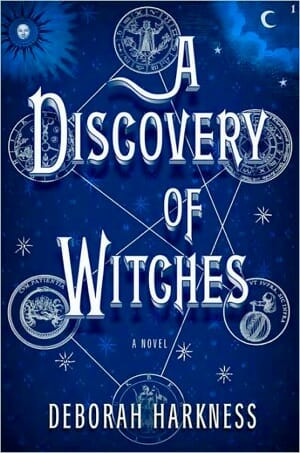Deborah Harkness: A Discovery of Witches

Witch Lit:101
While tales of witches, vampires and demons have been haunting literature for more than a millennium, these otherworldly creatures remain trending topics in American pop culture. Today’s vampires are sexy leading men—albeit a bit moody— and the witches are a far cry from the weird sisters who incant “double, double toil and trouble” around a cauldron in Macbeth. In fact, witches (the good ones, at least) have now supplanted the fair maidens and princesses in fairy tales.
Let’s blame Anne Rice.
Her wildly popular book series The Vampire Chronicles, introduced in 1976 with Interview with the Vampire, was quite different from Bram Stoker’s Dracula, epitomized on screen by Béla Lugosi. Rice’s vampires don’t transform into bats and aren’t fazed by garlic or crosses. They’re well-manned and supernaturally beautiful. (Remember the film version featured Tom Cruise as Lestat, Brad Pitt as Louis, and Antonio Banderas as Armand—not one of them bore a toothy resemblance to Lugosi or F.W. Murnau’s Nosferatu.)
Lestat’s sex appeal paved the way for writers like Stephenie Meyer and her best-selling Twilight series, a wildly popular four-part vampiric romance where the star-crossed lovers are an American teen Bella Swan and a relatively young 108-year-old vampire, Edward Cullen. And wizards and witches have become heroes to the teen and ’tween set, thanks to J.K. Rowling’s Harry Potter. In Potter’s adventures, we were introduced to an entirely new magical world, where we rooted for the orphaned boy wizard and actually felt sorry for the Muggles—humans without magical powers.
Deborah Harkness has tapped into this otherworldly vein with her debut novel A Discovery of Witches. Equally historical fiction, fantasy and romance, the work conjures a brew of a number of pop literature elements, starting with an illicit love affair between an American scholar and athlete, who happens to be a witch, and a 1,500-year-old, wine-loving, yoga-practicing vampire. Maybe it sounds comical, but it’s not presented in such a way. Instead, it’s forbidden love, breaking the laws of co-mingling among the creature races—demons, witches and vampires—who live among humans. Much of the book follows the lengths our protagonists go in order to be together. Call it “witch lit.”
We first meet our intrepid, youngish heroine Diana Bishop as she recalls a few archival manuscripts from Oxford’s Bodleian Library. The scholar is on leave from a tenured teaching post at Yale and is continuing research on the history of science, specifically the Newtonian era of the late 17th century where science begins to overtake the belief in alchemy and magic.
Diana immediately recognizes that one of the alchemical manuscripts, Ashmole 782, is bewitched. Her skin prickles at every touch of the leather-bound volume, and she is immediately both drawn and repulsed. Naturally—or unnaturally—Diana Bishop comes from a long line of powerful witches, descending from Bridget Bishop, the first woman executed for witchcraft in Salem, Massachusetts, in 1692. Diana has been denying her heritage and the use of magic, trying to pass as human her entire life. She can count on one hand the number of times she’s used her powers in a year, and those instances were specific emergencies (like casting a spell on an overflowing washing machine).
Ashmole 782 turns out to be a palimpsest—a manuscript hidden in a manuscript—believed lost until Diana unwittingly recalls it from the stacks. With manuscript in hand, she attracts unwarranted attention by vampires, witches and demons at Oxford who want to possess it and know the secrets it may hold. They’ll use force, if necessary, to extract the knowledge they need from Diana. One creature tracking her every move is fellow academician and doctor Matthew Clairmont.
Wouldn’t you know—he’s a vampire.
Clairmont has been searching for the missing manuscript for hundreds of years because he believes it could unlock the mysteries of the origins of demons, vampires and witches. These creatures are dying out, their powers weakening with every generation, so Clairmont’s vested interest is in preserving his own species.
-

-

-

-

-

-

-

-

-

-

-

-

-

-

-

-

-

-

-

-

-

-

-

-

-

-

-

-

-

-

-

-

-

-

-

-

-

-

-

-








































